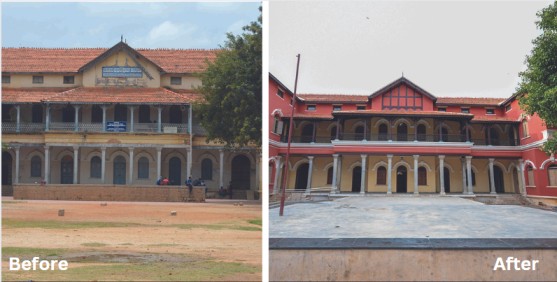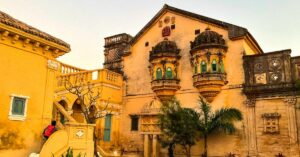Inside One Woman’s Quest to Restore Bengaluru’s Lost Heritage
The convenor of INTACH's Bengaluru Chapter, Meera Iyer has made the conservation of the city's forgotten heritage her life's mission. Here's the story of what inspired her to do so.

Growing up in a city like Agra, where a piece of living history awaits at every turn, moving to the startup hub of India—Bengaluru—was a strange feeling. As a self-proclaimed history enthusiast, I found myself missing the presence of heritage in the city. This changed when I connected with other history enthusiasts in Bengaluru, discovering that there is a rich history tucked away in some hidden spots.
Across the city, many people have been organising heritage walks and preservation drives to save this hidden cultural wealth. One such individual is Meera Iyer, who has dedicated more than a decade of her life to discovering and restoring unexplored heritage buildings, ensuring they are preserved for future generations.
The 53-year-old worked as a freelance writer before she decided to join INTACH (Indian National Trust for Art and Cultural Heritage), a non-profit charitable organisation dedicated to the conservation of unprotected architectural heritage all over India, to preserve Bengaluru’s forgotten heritage.
“It’s both shocking and disheartening that many residents of the city are unaware of the presence of heritage buildings. These structures, some dating back hundreds of years, are slipping into obscurity with no one to preserve their historical significance,” Meera Iyer, the convenor of INTACH tells The Better India.
For the love of the city and its heritage
Raised in Bengaluru, Meera has always harboured a keen interest in exploring the city’s rich heritage. “I used to visit many lesser-known structures around the city. As an enthusiast, I enjoyed uncovering these hidden gems and had always aspired to make a meaningful contribution,” she says.
Before joining INTACH, Meera worked as a freelance writer, focusing on topics related to forests and science. “I hold a PhD in forest ecology and spent some time in the US. When I returned to India, I initially pursued freelance writing before discovering my true passion for heritage preservation,” she recalls.
A pivotal moment that redirected her career path was a visit to Devanahalli Fort. “During my visit, I realised that there was a lack of information online about its history and heritage. This 18th century building is gradually fading into obscurity, losing in the debris of time,” she says.
“The significance of this place is not only historical but also architectural. In any other country in the world, there would have been people passionately advocating for its recognition, but here, it was as if no one even knew about it,” she adds.
With the determination to save as many heritage buildings as possible, in 2007 she joined INTACH.
“That realisation became the catalyst for me to get involved. There are many such overlooked places, but this one, in particular, was a major turning point. Visiting these locations, and especially finding a complete absence of information on site, fueled my determination to take action,” she says.
Discovering the city through a historical lens
Speaking on the topic of what truly constitutes history in the eyes of people, Meera comments, “There are thousands of monuments in the country protected by the ASI. However, there are also small temples, buildings, schools, and homes that hold historical significance. The challenge lies in preserving them. I understand that it’s not feasible to protect every fragment of the past, but there must be a way to document and raise awareness about these sites so that more of our history can be retained.”
At INTACH’s Bengaluru Chapter, Meera informed they cover largely two aspects of heritage preservation. “First, we host heritage walks to familiarise people with their city’s heritage. Our walks primarily focus on the local community, targeting the citizens of the city. While we do welcome tourists and travellers, our emphasis on engaging the local population is evident. This commitment is reflected, for instance, in being one of the few organisations in the city that conducts walks in the local language, Kannada. Our goal is to ensure that people from all walks of life are acquainted with the city.”
Meera initiated outreach efforts through the publication of a book called, ‘Discovering Bengaluru’. It delves into the history and evolution of nine older neighbourhoods in the city.

She says, “It is a collection of eleven fiction stories set in Bangalore, incorporating historical elements like time travel and narratives spanning various eras, was introduced. These literary works contribute to our outreach efforts, aiming to connect with a broader audience.”
The group has done hundreds of heritage walks in the local language.
The second part is where the organisation is actually working on the conservation of heritage, the actual conservation and restoration of buildings. “The team at INTACH starts from looking for a prospective building, then securing funding and then finding architects and engineers that are ideal for the project,” she says.
“We have worked on several projects in the years so far. Every building that we restore becomes an important part of our routines. It is very hard to restore a building and keep its history and heritage intact. It is something that needs patience and a pair of delicate hands,” she says.
In the past years, they have restored buildings in and around Bengaluru such as Mayo Hall, Tipu’s Armoury, Gangubai Hangal, Museum, the Old OPD Building at NIMHANS which is now a museum, the Oriental Research Institute in Mysuru among others.
“We’ve been involved in the construction of two buildings in Shimoga for the Shimoga Smart City initiative. One is the Government Middle School, and the other is the Shimoga Corporation building, both completed last year. Currently, our focus is on the ongoing projects, including Mani Villas, the institute, and a train station called Nandi Halt,” she adds.
Talking about the various difficulties her team faces she says, “We face numerous issues, with funding being the major hurdle. The government doesn’t consistently allocate funds to us, compelling us to seek support from private sources. However, securing funding from private entities is quite challenging since not many are inclined to invest in extensive restoration projects. Although several companies have CSR funds, those funds typically prioritise projects related to health, women, and children.”
“The disinterest in preserving this heritage is also because, for many people, the idea of heritage is a fort or a temple,” she adds. “However, we have been lucky enough to somehow find enthusiastic individuals wanting to contribute as well as government funding here and there to survive.
Another issue that Meera brings up in our conversation is the lack of stringent preservation rules in Bengaluru.
Discussing the situation in places like Mumbai, particularly South Bombay and the Colaba area, she notes, “Many buildings there have been officially declared protected and designated as heritage by the City of Bombay. In contrast, in Bengaluru, although we theoretically have a similar concept, the city lacks an effective implementing agency. In practical terms, we don’t possess a robust regulatory framework for heritage protection in Bengaluru. This poses a significant issue and a considerable challenge.”
“Besides awareness and restoration, we are always trying to work with the government to try and get them to do something about getting heritage legislation,” she notes.
Talking about the future, Meera says, “My ultimate goal is to find myself without a job. This scenario signifies the perfect situation where heritage is fully protected, and the community as a whole is deeply invested in its preservation. In such an ideal state, there wouldn’t be a need for an active role in heritage protection anymore. While the realisation of this goal may be uncertain and not immediate, it remains a significant aspiration.” If you found our stories insightful, informative, or even just enjoyable, we invite you to consider making a voluntary payment to support the work we do at The Better India. Your contribution helps us continue producing quality content that educates, inspires, and drives positive change. Choose one of the payment options below for your contribution- By paying for the stories you value, you directly contribute to sustaining our efforts focused on making a difference in the world. Together, let’s ensure that impactful stories continue to be told and shared, enriching lives and communities alike. Thank you for your support. Here are some frequently asked questions you might find helpful to know why you are contributing?

You can find INTACH Bengaluru chapter work here.
(Edited by Padmashree Pande)
This story made me
-
97
-
121
-
89
-
167













